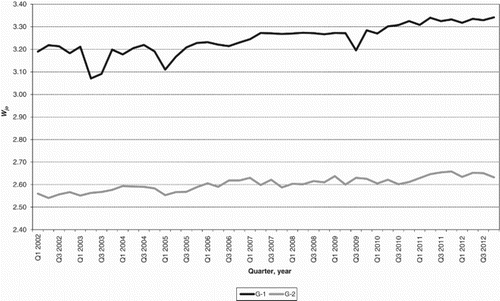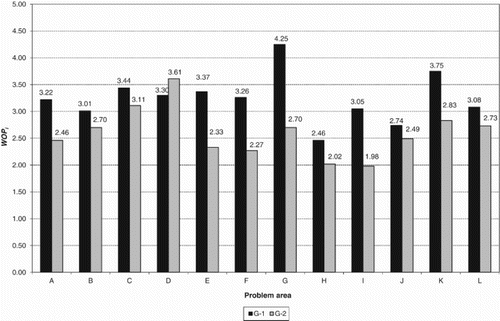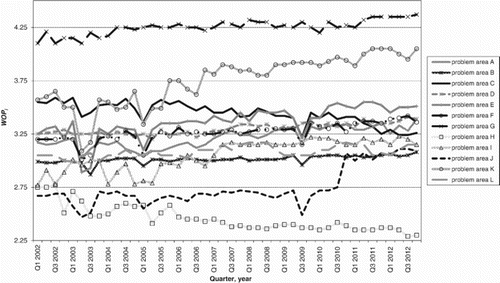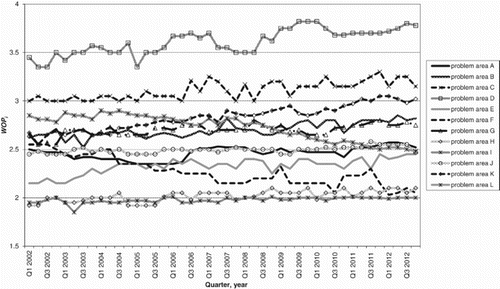Abstract
The audit of the health and safety management system is understood as a form and tool of controlling. The objective of the audit is to define whether the undertaken measures and the obtained results are in conformity with the predicted assumptions or plans, whether the agreed decisions have been implemented and whether they are suitable in view of the accepted health and safety policy. This paper presents the results of an audit examination carried out on the system of health and safety management between 2002 and 2012 on a group of respondents, the employees of two mining departments (G-1 and G-2) of Jan, a coal mine. The audit was carried out using the questionnaire developed by the author based on the MERIT-APBK survey.
1. Introduction
The level of work safety stems from the impact of the energetic hazard factor and the attitudes and behaviour of employees. The quality of the applied technical solutions is being constantly improved, reaching a satisfactory level, and therefore the reasons explaining why accidents (dangerous incidents) happen are frequently attributed to the way work tasks are carried out. Inattention and failure to follow the required applicable regulations are habitually the main cause of accidents and material loss. A thesis can be put forward propounding that there are reasons why people behave in a way that leads to an accident. These reasons may take the form of barriers, and their identification and elimination can ensure safer workplaces. Human error (human factor error) is the resultant of technical, organizational and psychological factors affecting an individual. Human error is defined as an action which deviates from the required standards and requirements of a situation.[Citation1–5] We can distinguish omission (negligence) errors and execution errors (giving wrong instruction or providing wrong information, wrong sequence of task realization, run-time errors) which appear when the required procedures or standards of conduct are breached. As the surveys demonstrate, not only the improvement of working conditions, but also the elimination of dangerous behaviours and dangerous activities results in the rise of workplace safety levels.[Citation6–10] Therefore, the behaviour-based safety (BBS) methodology is becoming increasingly popular. The methodology is based on the assumption that the level of occupational health and safety (OHS) depends on the combination of three measurable factors: an employee, their behaviour and the environment. BBS encourages the employees to get involved in the issues of work safety improvement (joint responsibility for the OHS level).[Citation11]
In Poland, the term OHS management became popular in the mid-1990s and involved principally matters connected with the organization and decision-making processes in a company. The need to implement the health and safety management rules was enforced not only by low efficiency of the analysis methods of safety condition used at that time, but also by legal aspects (the need to adjust the legal solutions in Poland to the requirements applicable in the member states of the European Union), economical aspects (different insurance premiums) and social reasons (no consent to work in high hazard and accident conditions).
The management process of the OHS must provide means and tools ensuring proper monitoring of the undertaken actions and their supervision along all management levels. These objectives are realized, among other things, by the use of audit examinations of the health and safety management system. In accordance with the Polish Standard, audit is a systematic and independent examination with the aim to determine whether proper actions are undertaken, whether the obtained results correspond to the expected arrangements and whether these arrangements have been implemented.[Citation12]
With respect to the audit of the health and safety management system, it is also worthwhile emphasizing that every single employee can take part in it. Every employee can participate in the assessment process of the health and safety management system.
In the audit examinations of the health and safety management system we can single out a strategic audit (company level), tactical audit (level of company organizational units) and operational audit (executive level). In each of these cases, both the internal and external audits can be performed. The examinations can include the entire community (surveys of the entire population, called exhaustive surveys) or the selected units only (called non-exhaustive surveys).Footnote1 This article discusses the results of an external audit performed on a group of employees from two mining departments, i.e., departments G-1 (129 people) and G-2 (143 people) at Jan, a coal mine. The author's questionnaire based on the method management evaluation regarding itemised tendencies (MERIT) method [Citation13] was used in the surveys. The number of people in the two groups taking part in the audit ranged from 80 to 123, which accounted for 62–86% of the total number of employees working in the departments. The audit examinations were carried out every quarter between 2002 and 2012, and they were developing the research problem investigated by the author in his doctoral dissertation.[Citation14]
2. Questionnaire surveys as a research tool for quality assessment of health and safety management
Questionnaire surveys were used for the quality assessment of health and safety management at the organizational level (departments) selected for the audit from the organizational structure of Jan. In such surveys, three basic phases can be identified: survey design phase, data collection phase and result analysis phase.
In the first phase the problem is formulated, the situation is analysed and the research task is defined. The second phase includes the analysis of secondary data,Footnote2 the determination of the primary data collection method,Footnote3 the testing of research tools and the execution of surveys, while the third phase consists of the analysis and interpretation of data and the assessment of results.
In the questionnaire surveys, the respondents replied in writing to 26 questions divided into 12 problem areas (A–L):
Area A. Assessment of task setting at the department, taking into consideration the OHS issues.
Area B. Assessment of work adjustment to psychophysical abilities of the employees.
Area C. Assessment of the reliability of machines and work tools as well as their availability at workplaces.
Area D. Assessment of the knowledge of OHS issues necessary for safe working.
Area E. Assessment of the promotion quality of OHS principles at workplaces within the department.
Area F. Assessment of the incentives motivating to safe work at the department.
Area G. Assessment of the occupational risk related to the performed activities.
Area H. Assessment of the knowledge of near-miss incident investigations conducted at the department.
Area I. Assessment of the knowledge of the principles of modern health and safety management.
Area J. Assessment of the quality of OHS training carried out at the department.
Area K. Assessment of the organization of safe work at the department.
Area L. Assessment of law and order at the department.
Each respondent was to choose only one answer to each of the questions, scored from 0 to 5 (0 = fail, 5 = ideal), i.e., the answer which, in their opinion, provides the best description of the realization status of the activities undertaken in a specific health and safety management area at their department. Based on the obtained answers, rating indexes were determined for individual problem areas (WOPi), and then the health and safety management quality rating index (Wjo) was determined for the entire department as the arithmetic mean of WOPi values. The mathematical model used in the examinations was discussed in the doctoral dissertation of the author.[Citation14]
3. Discussion of survey results
The values of partial (WOPi) and final (Wjo) ratings are shown in Figures –
Figure 1. Department-wide operational audit of the health and safety management system: values of the final rating index jo in successive editions for departments G-1 and G-2.

Figure 2. Department-wide operational audit of the health and safety management system: arithmetic means of WOPi ratings for individual problem areas between 2002 and 2012. Note: WOPi = partial rating.

Figure 3. Department-wide operational audit of the health and safety management system (department G-1): summary of WOPi rating indexes between 2002 and 2012. Note: WOPi = partial rating.

Figure 4. Department-wide operational audit of the health and safety management system (department G-2): summary of WOPi rating indexes between 2002 and 2012. Note: WOPi = partial rating.

The summary of evaluation measures of goodness of fit between the trend function and the set of empirical data is presented in
Table 1. Evaluation measures of goodness of fit between the theoretical data of the trend function and the set of empirical data.
Table 2. Areas of variability and mean values of partial ratings for departments G-1 and G-2.
Table 3. Variability index of partial ratings for departments G-1 and G-2.
Table 4. Department G-1: raw and adjusted frequency indexes for individual quarters by problem area.
Table 5. Department G-2: raw and adjusted frequency indexes for individual quarters by problem area.
A linear trend function was used for the description of changes in the rating indexes. In the case of the values of the final rating index Wjo, the fitting of the trend function for the investigation results of both departments was similar: for department G-1 the coefficient of determination R2 was 0.7147 (trend function ŷt = 0.0043t + 3.148) and for the department G-2 it was 0.7737 (trend function ŷt = 0.0021t + 2.5549).
With reference to the individual areas, the best fitting of the trend function (
K ‘Assessment of the organization of safe work at the department’ (department G-2): 92.1% (standard error of parameter a = 0.0004, standard error of parameter b = 0.0122),
L ‘Assessment of law and order at the department’ (department G-2): 82.9% (standard error of parameter a = 0.0007, standard error of parameter b = 0.0169),
F ‘Assessment of the incentives motivating to safe work at the department’
(department G-2): 76.8% (standard error of parameter a = 0.0009, standard error of parameter b = 0.0221),
With respect to the department-wide operational audit carried out in department G-1, the best fitting of the trend function was observed for areas:
H ‘Assessment of the knowledge of near-miss incident investigations conducted at the department’: 73.6% (standard error of parameter a = 0.0005, standard error of parameter b = 0.0122),
K ‘Assessment of the organization of safe work at the department’: 73.5% (standard error of parameter a = 0.0004, standard error of parameter b = 0.0112),
I ‘Assessment of the knowledge of the principles of modern health and safety management’: 71.7% (standard error of parameter a = 0.0003, standard error of parameter b = 0.0071).
The worst fitting of the trend function was observed for areas:
L ‘Assessment of law and order at the department’ (department G-1): 30.1% (standard error of parameter a = 0.0007, standard error of parameter b = 0.0169),
A ‘Assessment of task setting at the department, taking into consideration the OHS issues’ (department G-2): 33.7% (standard error of parameter a = 0.0006, standard error of parameter b = 0.0162),
I ‘Assessment of the knowledge of the principles of modern health and safety management’ (department G-2): 37.6% (standard error of parameter a = 0.0003, standard error of parameter b = 0.0071),
G ‘Assessment of occupational risk related to the performed activities’ (department G-2): 39.8% (standard error of parameter a = 0.0005, standard error of parameter b = 0.0141).
The downward tendencies of the trend function were observed for four problem areas: C ‘Assessment of the reliability of machines and work tools as well as their availability at workplaces’ (a = −0.0063), F ‘Assessment of the incentives motivating to safe work at the department’ (a = −0.0101), H ‘Assessment of the knowledge of near-miss incident investigations conducted at the department’ (a = −0.0082) and L ‘Assessment of law and order at the department’ (a = −0.0093). For areas C and H the downward tendencies involve department G-1, and for areas F and L the downward tendencies involve department G-2.
The highest growth dynamics was observed for areas K (a = 0.0158) and J (a = 0.0101), assessed in the audit by the staff of department G-1.
Due to the impact of seasonal fluctuations, the differences between the determined rating index and the trend were the highest for area K ‘Assessment of the organization of safe work at the department’ (in the 4th quarters the value WOPK was higher as compared to the trend by 0.046) and for area J ‘Assessment of the quality of OHS training at the department’ (in the 4th quarters the value WOPJ was higher as compared to the trend by 0.032). In both cases, the obtained results involve the results of audit examinations carried out in department G-1 (Tables
The mean value of the final rating index Wjo was 3/24 for department G-1 between 2002 and 2012 and 2.60 for department G-2. In neither quarter was the final rating index of the department-wide operational audit Wjo for department G-2 higher than that obtained for department G-1 (
The determined values of variability indexes (
In the opinion of the respondents from department G-1, the instructions they are given are clear and comprehensible (WOPA = 3.22). However, the employees are not informed how to safely execute the assigned tasks in spite of the fact that workplaces are supervised on a regular basis. The employees know how to fulfil their obligations safely (WOPD = 3.3) and they can use the possessed knowledge practically (WOPK = 3.75).
As to the supervising staff in department G-2, the tasks are formulated in an unclear manner, while the control over the performed works is occasional (WOPA is only 2.46). Most employees declare that they have sufficient knowledge and skills to fulfil their obligations safely (WOPD = 3.611 and WOPK = 2.83).
The assigned tasks often exceed the psychophysical abilities and capabilities of the staff, and the measures aiming to reduce the workload the employees are burdened with are undertaken occasionally (department G-1) or seldom (department G-2). For department G-1 the WOPB index is 3.01 (10th place in the problem area ranking) and for department G-2 the WOPB index is 2.702 (5th place in the problem area ranking).
In the opinion of the respondents, only a small part of machines and equipment does not meet safety requirements (e.g., damaged rope windlass shields or malfunctioning loudspeakers on walls). In most cases the employees have access to operational tools in good condition and to proper protective equipment which they use as instructed. In the ranking of problem areas, area C was placed third (WOPC = 3.44 in the audit in department G-1) and second (WOPC = 3.11 in the audit in department G-2).
In the case of department G-1, modern and comprehensible means promoting work safety rules are used (e.g., large outdoor screens), and the information provided to the staff is updated on a regular basis (WOPE = 3.37). In department G-2, the promotion of OHS rules is rather occasional (WOPE = 2.33). In the department's system of rewards and punishments (department G-1), the positive motivation system promoting proper behaviour and attitudes of employees is predominating (WOPF = 3.26). In the case of department G-2, this system is unclear and used selectively (WOPF = 2.27).
In the opinion of the employees of department G-1, the assessment of occupational risk is carried out for each workplace and all employees are informed about the level of such risk. Area G got the mark 4.25 and took the first place in the ranking. For department G-2 this area was placed 6th (WOPG = 2.701). In this case the employees claim that they are informed about the level of risk, but the rating itself is updated occasionally.
In the opinion of the respondents, near-miss incidents are hardly ever analysed. It is possible to report such situations, but they are not reviewed. In the audit examinations carried out in department G-1, this area was placed last in the problem areas ranking (WOPH = 2.46), while in the case of the audit carried out in department G-2, it finished last but one (WOPH = 2.02).
With respect to the staff of department G-1 we can say that they know basic principles and procedures of the health and safety management programme used at the coal mine (WOPI = 3.05). In the case of department G-2, the employees have no knowledge about the basic principles and procedures of the health and safety management programme. This is the only area with the rating index below 2 (WOPI = 1.98). The employees from this department had no knowledge of the objectives of this programme and did not know that they could participate in the programme, evaluating the decisions made with regard to work safety management.
The quality of OHS training was assessed as poor (WOPJ = 2.74 for department G-1 and WOPJ = 2.49 for department G-2). The reasons for this situation can be attributed to the limited time dedicated to weekly OHS training. In the opinion of the respondents, the information from post-accident statements is not discussed and the content of periodic OHS briefings for the supervision personnel is passed out to the staff occasionally.
The order at workplaces at the department is reposted mainly by the staff of department G-1 (WOPL = 3.08). The situation in this respect is definitely worse in department G-2 (WOPL = 2.73). In the opinion of the respondents, there are frequent conflicts between employees.
4. Conclusion
The management of health and safety is frequently considered to be as important as production. Such an attitude has been enforced by economic calculation, legal regulations as well as the lack of social consent to work in conditions that pose hazards to human life or health. Therefore the application of OHS controlling is becoming more common. The audit of the health and safety management system, viewed as a form and tool of controlling, is an example of a modern research instrument. It allows us to analyse the potential hazard and then to identify and implement necessary preventive measures. The safety management is based on the assumption that dangerous activities, work conditions and accidents should be treated as phenomena (incidents) which reflect malfunctions of the management system. The audit of the health and safety management system allowed us to propagate the idea of participation among the staff (the awareness of co-responsibility for the matters involving OHS), which is also in compliance with the methodology of BBS.
In the author's opinion, the surveys presented in this article may supplement the MERIT method used in coal mines for the assessment of the health and safety management quality at the strategic level. The discussed research studies not only allow us to keep track of the changes in the values of rating indices in time, but they will also be helpful to identify ‘strong’ and ‘weak’ aspects of OHS management at particular departments of a company.
In the case of both audited departments, the assessment of conditions under which the work tasks are performed has been confirmed by accident statistics. Between 2002 and 2012, no fatal accidents were reported in department G-1 (Wjo = 3.24), whereas in department G-2 (Wjo = 2.60) there was one fatal accident. Within the referred period, in department G-1, 78 accidents were reported altogether, including one serious one, while in department G-2 there were 125 accidents, including six serious ones. No fatal or mass accidents were reported in either department.
Disclosure statement
No potential conflict of interest was reported by the authors.
Notes
1. Steczkowski [15] discusses the essence of the representative sampling methods.
2. Data collected for other purposes.
3. Information collected for specific research purposes (field research).
References
- Bukowski K, Gasparski P, Klonowicz T, et al. Psychologia i bezpieczeństwo pracy [Occupational psychology and safety]. Warszawa: Wydawnictwo Książkowe Instytutu Psychologii PAN; 1992.
- Cieślak A, Dobiech J, Górski M, et al. Zapobieganie stratom w przemyśle. Cz. III. Zarządzanie bezpieczeństwem procesowym [Loss Prevention in the industry. Part III. Process safety management]. Łódź: Wydawnictwo Politechniki Łódzkiej; 2000.
- Reason J. Human error. New York: Cambridge University Press; 1990.
- Szopa T. Niezawodność i bezpieczeństwo [Reliability and safety]. Warszawa: Wydawnictwo Książkowe Oficyny Wydawniczej Politechniki Warszawskiej; 2009.
- Wiegmann DA, Shappell SA. Human error perspectives in aviation. The International Journal of Aviation Psychology. 2001;11:341–357. doi: 10.1207/S15327108IJAP1104_2
- Cheyne A, Cox S, Oliver A, et al. Modelling safety climate in the prediction of levels of safety activity. Work and Stress. 1998;12(3):255–271. doi: 10.1080/02678379808256865
- Mearns K, Flin R, Gordon R, et al. Measuring safety climate on offshore installations. Work and Stress. 1998;12(3):238–254. doi: 10.1080/02678379808256864
- Neal A, Griffin MA. Study of the lagged relationships among safety climate, safety motivation, safety behavior, and accidents at the individual and group levels. J. Appl Psychol. 2006;91(4):946–953. doi: 10.1037/0021-9010.91.4.946
- Pidgeon N. Safety culture and risk management in organizations. Journal of Cross-Cultural Psychology. 1991;22:129–140. doi: 10.1177/0022022191221009
- Zohar D. Safety climate in industrial organizations: theoretical and applied implications. J. Appl Psychol. 1980;65(1):96–102. doi: 10.1037/0021-9010.65.1.96
- McSween TE. The values-based safety process; improving your safety culture with behavior-based safety. 2nd ed. New York: Wiley; 2003.
- Polski Komitet Normalizacyjny (PKN). System zarządzania bezpieczeństwem i higieną pracy. Wymagania [Health and safety management system. Specifications] (Standard No. PN-N–18001:2004). Warszawa: PKN; 2004.
- Arrington-Webb LA, Loyd E. ISO 9002 certification helps thiele kaolin. Mining Engineering. 1997;49(2):23–25.
- Korban Z. Analiza strukturalnego zróżnicowania jakości zarządzania bezpieczeństwem pracy na przykładzie kopalni węgla kamiennego [Analysis of structural diversification of work safety management quality illustrated with an example of a coalmine] [doctoral dissertation]. Gliwice; 2001.
- Steczkowski J. Metoda reprezentacyjna w badaniach zjawisk ekonomiczno-społecznych [Representative sampling method in the economic and social investigations]. Warszawa: Wydawnictwo Naukowe PWN; 1995.
